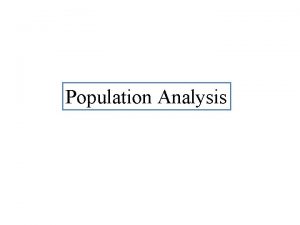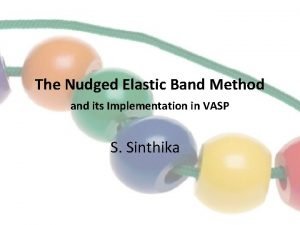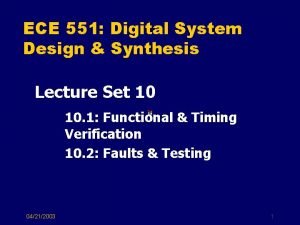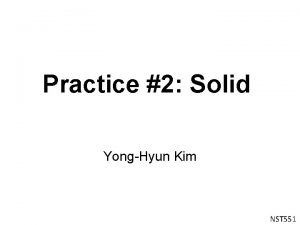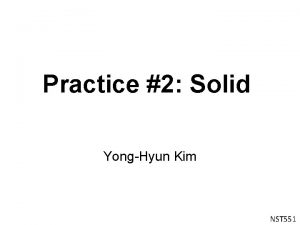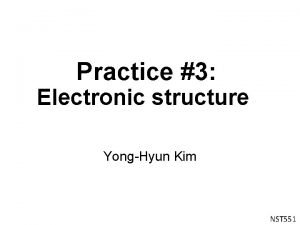Practice 2 Solid YongHyun Kim NST 551 VASP








- Slides: 8

Practice #2: Solid Yong-Hyun Kim NST 551

VASP • VASP ? The Vienna Ab initio Simulation Package (VASP) is a computer program for atomic scale materials modelling, e. g. electronic structure calculations and quantum-mechanical molecular dynamics, from first principles. https: //www. vasp. at/ Input POSCAR : Initial atomic position KPOINTS : K-point sampling parameters POTCAR : Pseudo potential, ex-co. Energy INCAR : Input parameters for calculation OUTCAR run. sh : parallel computing : Overall calculation results (total energy, force. . ) Output CONTCAR : Atomic position WAVECAR : Wavefunctions : Charge densities DOSCAR : DOS : Eigenvalues . . . CHGCAR EIGENVALUE http: //cms. mpi. univie. ac. at/vasp/vasp. html

Input- INCAR http: //cms. mpi. univie. ac. at/vasp/vasp. html System =graphene • System’s name ISTART=0 ICHARG=2 • Whether to read the file WAVECAR or not. (0 -new 1 -cont. 2 -samecut) • How to construct the 'initial' charge density. (1 -file 2 -atom) GGA_COMPAT=. FALSE. ISPIN = 1 SYMPREC=1 E-2 • Refer to the manual. (. FALSE. is recommended) • 1 - non spin polarized calculations, 2 - spin polarized calculations. • How accurate the positions in the POSCAR file must be for symmetry. ENCUT=400 prec=Normal NELMIN=4 EDIFF=1 E-5 EDIFFG=-0. 02 • • • LREAL=. FALSE. ISMEAR = 0 ; SIGMA=0. 05 • . FALSE. - projection done in reciprocal space, . TRUE. - projection done in real space. • Partial occupancies. (0 -Gaussain, -1 -Fermi); The width of the smearing in e. V. NSW = 10000 ; ISIF=2 ; IBRION=2 POTIM=0. 1 NPAR=8 NSIM=4 LPLANE=. TRUE. ALGO=fast • The maximum number of ionic steps. ; Degrees of freedoms allowed to change. (2 cell shape and volume fixed); How the ions are updated and moved. (2 -the conjugate gradient algorithm) • Time-step for ion-motion (fs) • Do not modify this line • Refer to the manual. (4 is recommended) • Refer to the manual. (. TRUE. is recommended) • The electronic minimization algorithm. (fast is recommended) KBLOCK=1 NBLOCK=1 • Refer to the manual. (1 is recommended) LWAVE=. FALSE. LCHARG=. FALSE. LVTOT=. FALSE. • Create waverfunctions (WAVECAR) file. • Create charge densities (CHG/CHGCAR) files. • Create total local potential (LOCPOT) files. Energy cutoff in e. V. Refer to the manual. (Normal is recommended) The minimum number of electronic SC steps. Stopping-criterion for electronic update. Stopping-criterion for ionic update.

Input- POSCAR graphene 2. 51000000 1. 0000000000000000 0. 500000000 0. 8660254037844386 0. 0000000000000000 0. 00000000 10. 00000000 2 Direct 0. 3333333333333357 0. 500000000 0. 6666666666666643 0. 50000000 • System’s name • Lattice constant and unit cell coordinate - a 1 (x y z) - a 2 (x y z) - a 3 (x y z) • Number of atoms per unit cell. • Atomic position inside unit cell. (Direct-ratio, Cartesian-absolute coordinate(x, y, z)) • You can see the structure you made 1. Make a ‘input’ text file in the same directory with POSCAR. 2. Command ‘poscar. x’, and then ‘poscar. xyz’ file is made. 3. Command ‘xmakemol –f poscar. xyz’ to run program xmakemol. - input file 1 C 2 332 • Number of atom type • Atom symbol; Number of atom per unit cell • Size of cell http: //cms. mpi. univie. ac. at/vasp/POSCAR_file. html

Input- KPOINTS graphene 0 gamma 18 18 1 000 • • • System’s name Refer to the manual. (0 is recommended) Refer to the manual. (gamma is recommended) How many k-points are sampled each reciprocal axis. (b 1, b 2, b 3) Refer to the manual. (0 is recommended) Output- total energy • You have to check the total energy after calculation is finished. • Command ‘grep "free energy" OUTCAR | tail -1’

Cufoff - Energy 400 e. V 300 e. V graphene Si-diamond

Kpoints - Energy 20 8 graphene Si-diamond

Practice #2 • Find 2 converge parameters (cutoff, k-point) for graphene and Si-diamond solids.

